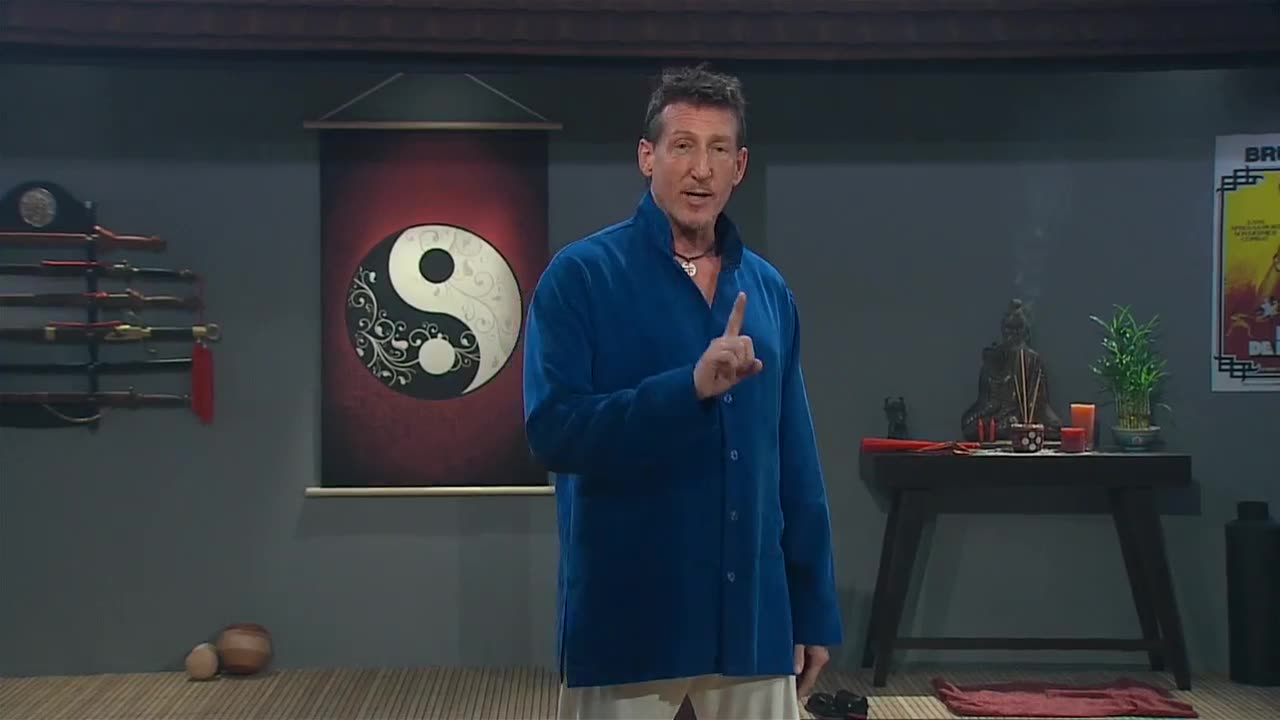Premium Only Content

18. The Peaceful Warrior
I
In this lecture, we’ll learn two new moves: golden rooster stands on one
leg, and step forward and punch opponent’s groin. We’ll also finish our
discussion of the eight original intentions by examining the final four and
how they relate to tai chi moves we’ve already learned.
Yòu zuǒ jīn jī dú lì (“Golden Rooster Stands
on One Leg [Left and Right]”)
● Next up is the move called yòu zuǒ jīn jī dú lì, which in English
means “golden rooster stands on one leg (right and left).”
● Shift the weight entirely onto the right foot, and raise the left knee
slowly. The left hand opens into a palm and swings past the outer
side of the left leg and then upward to the front, until the bent
elbow is just above the left knee, with the fingers pointing up and
the palm facing inward. At the same time, lower the right hand to
the side of the right hip, palm down.
● This is a two-step movement. Step down with the left foot and shift
the weight entirely onto it. Raise the right knee slowly. The right
hand swings past the outer side of the right leg and then upward
to the front. Keep going until the bent elbow is just above the right
knee with the fingers pointing up and the palm facing inward. At the
same time, lower the left hand to the side of the left hip, palm down.
Jìn bù zhǐ dāng chuí (“Step Forward
and Punch Opponent’s Groin”)
● Our next move is jìn bù zhǐ dāng chuí, which in English means
“step forward and punch opponent’s groin.”
● Slowly step the right foot down and slightly ahead, turning the right
toes out toward the north. Shift the weight onto the right foot and turn
the waist to the right. Circle the right hand outward and then down
to the belly, forming a loose fist with the right hand. Meanwhile, the
left hand circles out and then to the front (the west).
● Step forward with the left foot to form a bow step. At the same
time, brush around the left knee with the left hand and punch
downward at belly height with the right hand.
● After this move, the next movement in the routine is a repetition of
grasp the bird’s tail.
The Next Four Intentions
● As a reminder, the first four intentions we learned about were peng
(ward off), lu (roll back), ji (press), and an (push). Up next are tsai
(yank down), lieh (splitting apart), chou (give the elbow) and kao
(give the shoulder).
● Tsai means to take hold of something and draw it downward toward
the ground in a sharp and sudden fashion. You can see this action
in the move needle at the bottom of the sea. In the routine, you do
it in a slow, controlled manner, but it’s a sharp move nonetheless.
● Lieh means to send your opponent’s body in two directions at
once. A movement that involves this is parting the horse’s mane.
● Chou means giving the elbow. It’s a particularly interesting technique
because it can go around corners; for instance, it can reach around an
opponent’s guard. We saw this action in snake sticks out its tongue.
● Kao involves giving the shoulder. This is what you use when there’s
a distance between you and your opponent. Use of the shoulder is
hidden within several tai chi techniques. In the old traditional routine,
the shoulder move comes just before the crane spreading its wings.
-
 1:16:52
1:16:52
vivafrei
7 hours agoNEW STREAM! Sorry peeps
133K40 -
 5:56:14
5:56:14
SNEAKO
7 hours agoCheesur edate, Jake Shields on election
97.7K1 -
 39:34
39:34
Nerdrotic
9 hours ago $24.67 earnedAirbursts with Dr Malcolm LeCompte & Giants and Ancient Civilizations with Hugh Newman
91.7K9 -
 1:03:38
1:03:38
vivafrei
15 hours agoElection RECAP! Long-Count Chicanery! FULL Jan. 6 Pardons! Let's Mock Lichtman & MORE! Viva Frei
149K152 -
 LIVE
LIVE
Vigilant News Network
10 hours agoDoctors Drop Post-Election COVID Bombshell | Media Blackout
4,691 watching -
 14:13
14:13
Scammer Payback
12 days agoTelling Scammers Their Address
153K87 -
 5:43:21
5:43:21
Barstool Gambling
14 hours agoBig Cat and Co Sweat Out the Week 10 Sunday Slate | Barstool Gambling Cave
113K3 -
 2:49:36
2:49:36
The Jimmy Dore Show
2 days agoRumble Time Live w/ Jimmy Dore & Special Guests Roseanne Barr, Dr. Drew, Drea de Matteo & More!
577K666 -
 17:17
17:17
DeVory Darkins
1 day agoKamala Post-Election BOMBSHELL Exposes $1 BILLION Campaign DISASTER
102K181 -
 19:52
19:52
Stephen Gardner
1 day ago🔥HOLY CRAP! Trump just did the UNTHINKABLE!!
103K596